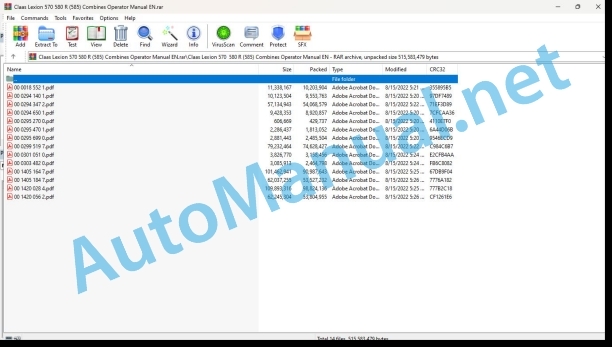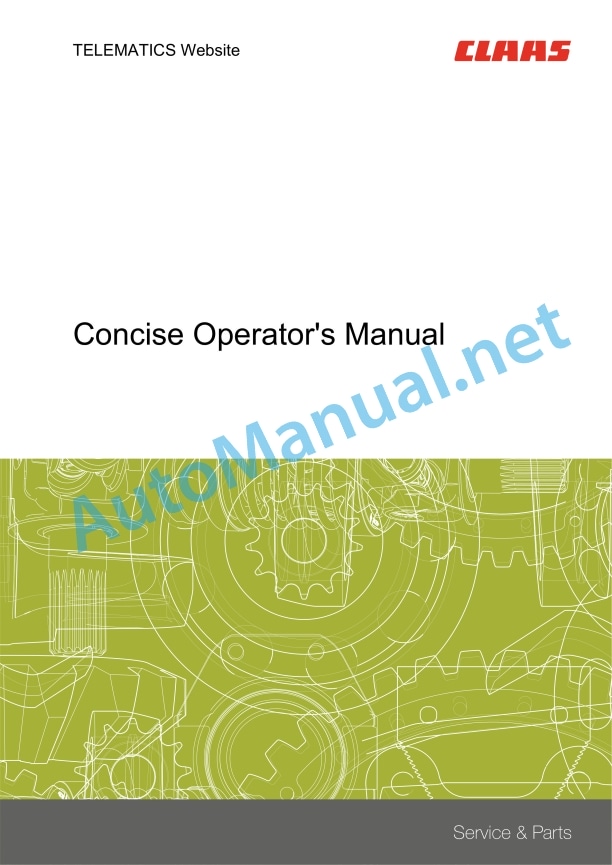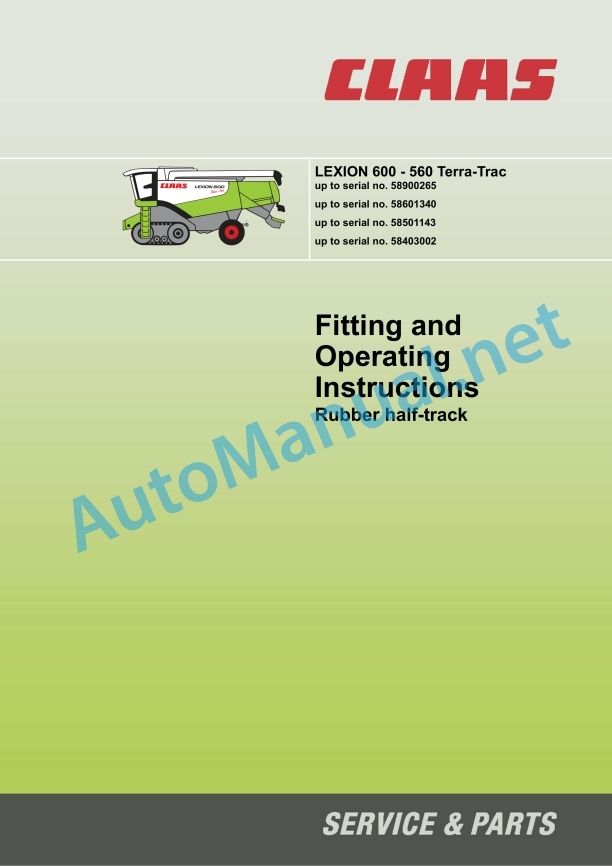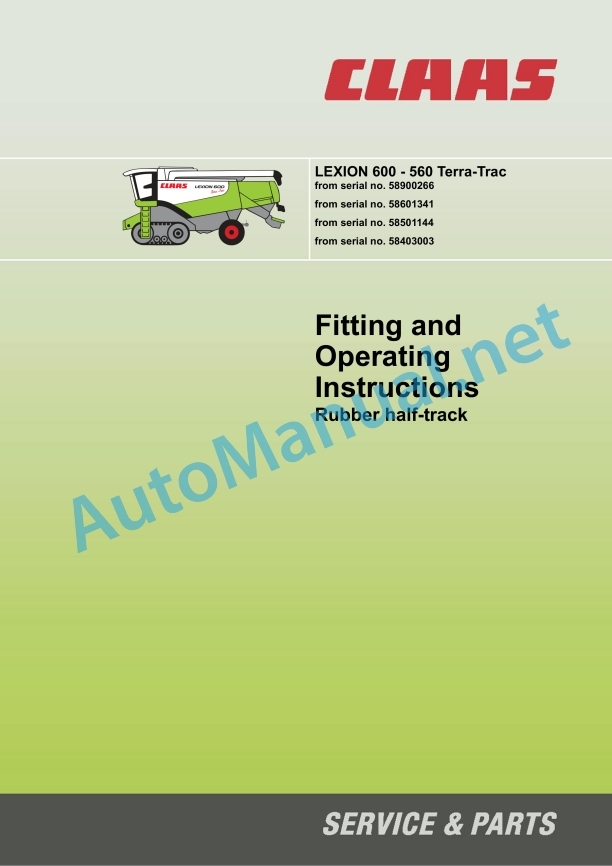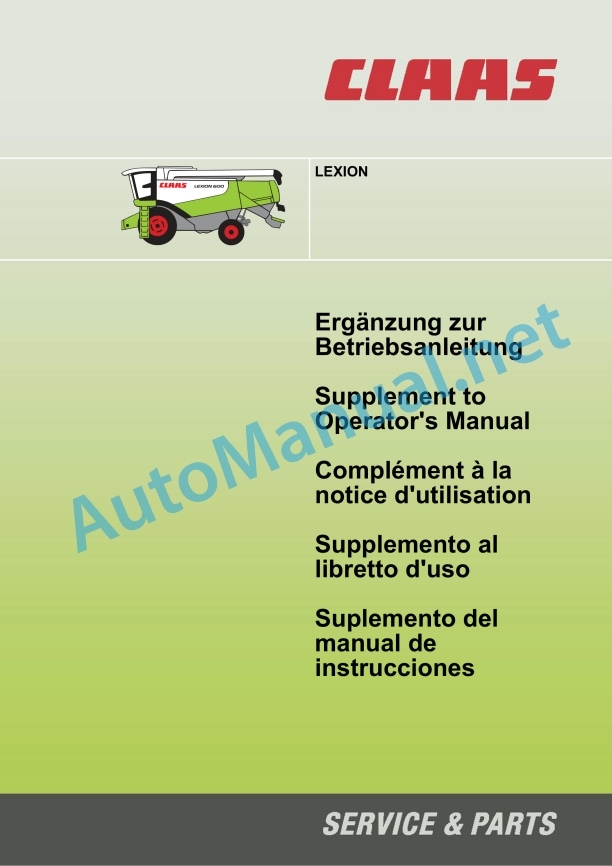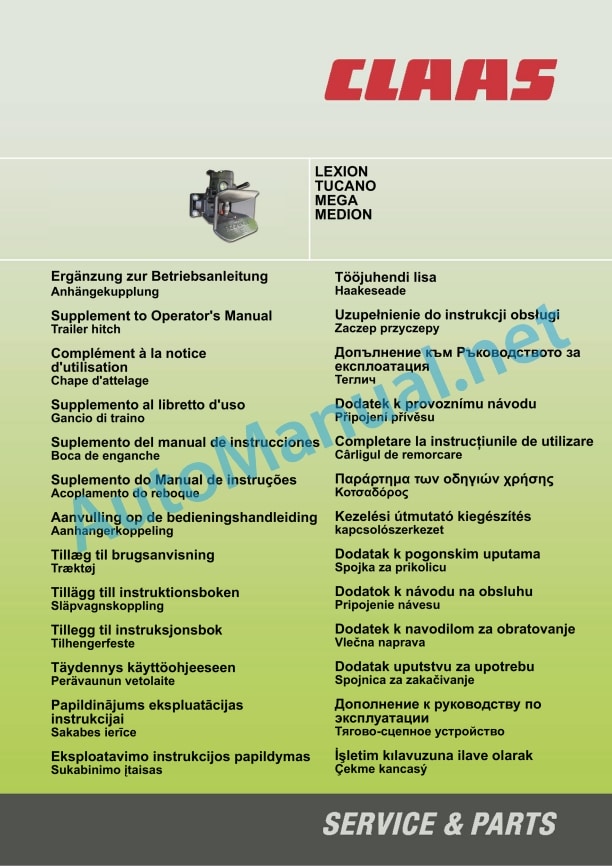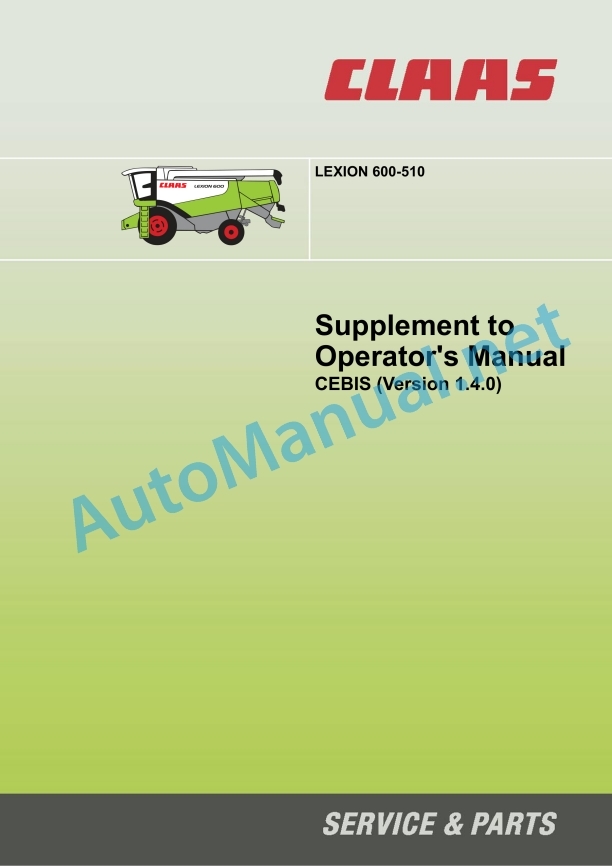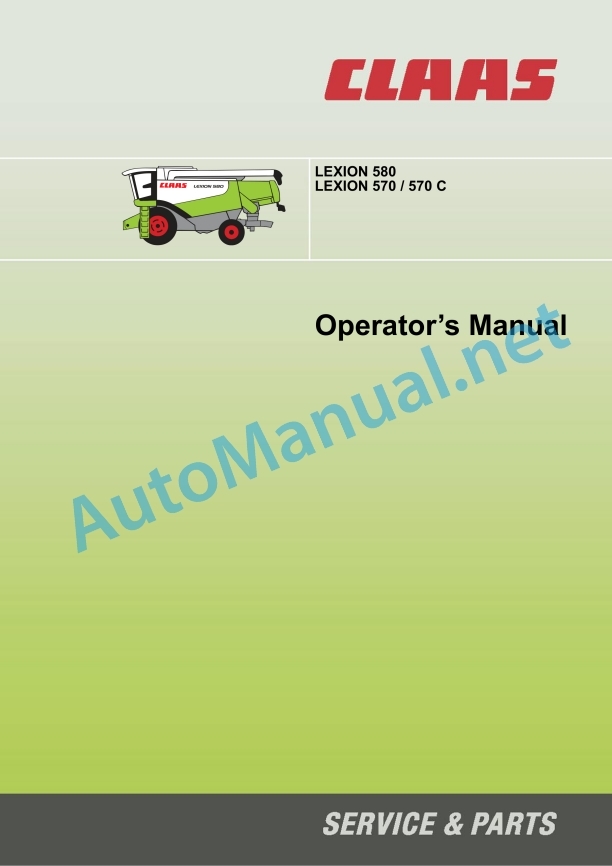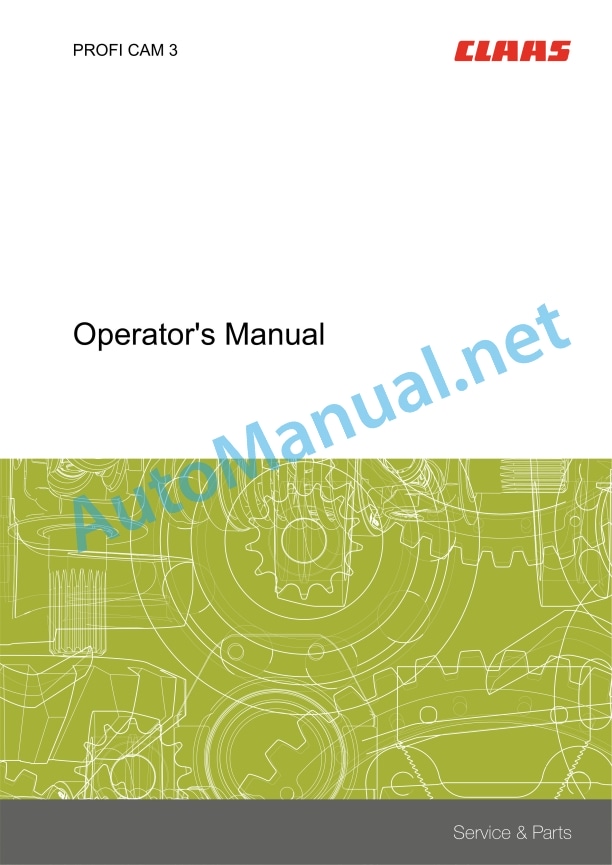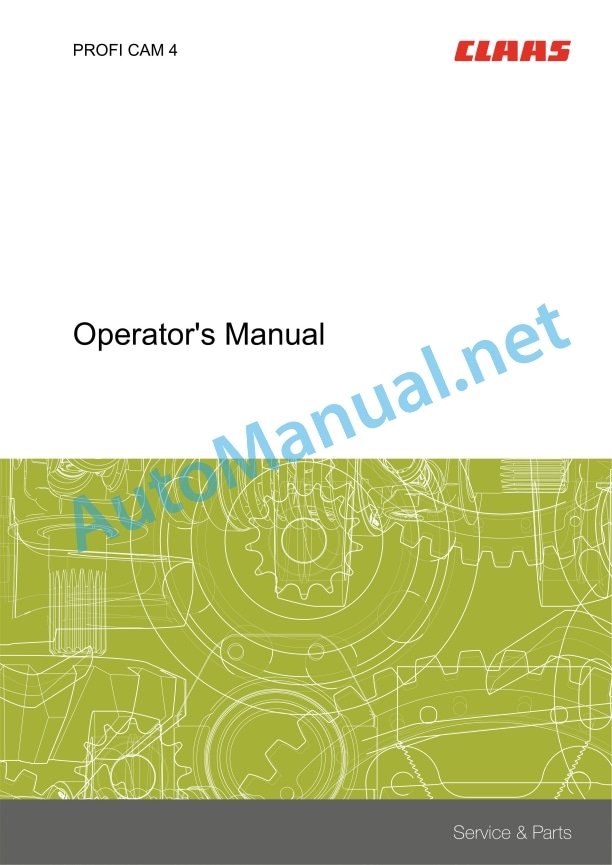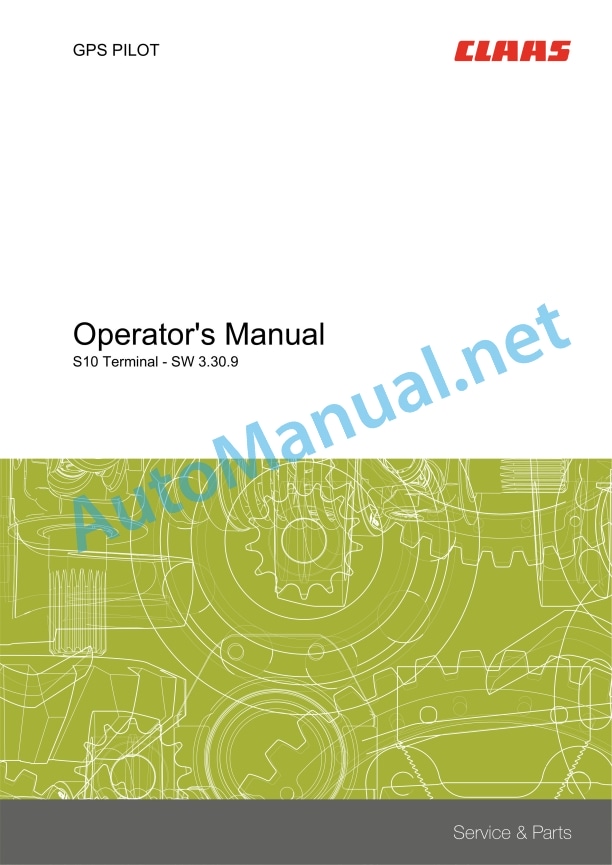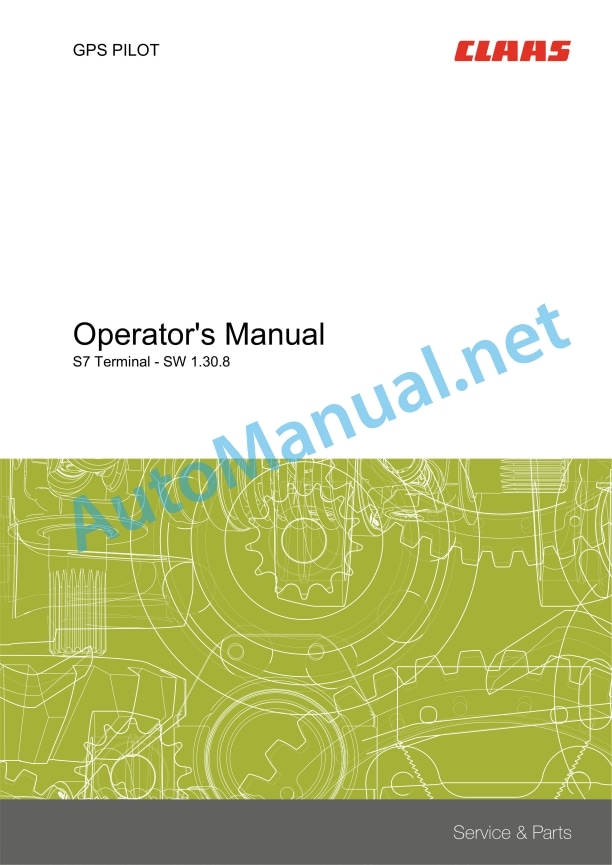Claas Lexion 570 580 R (585) Combines Operator Manual EN
$50.00
- Model: Lexion 570 580 R (585) Combines
- Type Of Manual: Operator Manual
- Language: EN
- Format: PDF(s)
- Size: 443 MB
File List:
00 0018 552 1.pdf
00 0294 140 1.pdf
00 0294 347 2.pdf
00 0294 650 1.pdf
00 0295 270 0.pdf
00 0295 470 1.pdf
00 0295 699 0.pdf
00 0299 519 7.pdf
00 0301 051 0.pdf
00 0303 482 0.pdf
00 1405 164 7.pdf
00 1405 184 7.pdf
00 1420 028 4.pdf
00 1420 056 2.pdf
00 0018 552 1.pdf:
TELEMATICS Website
Table of contents
1 About this Concise Operator’s Manual
1.1 Notes on the manual
1.1.1 Validity of manual
1.1.2 Notes regarding the Concise Operator’s Manual
1.1.3 Notes on warranty
2.1 Intended use
2.1.1 Proper use
3 Product description
3.1 Overview and method of operation
3.1.1 TELEMATICS product variants
3.1.2 TONI (TELEMATICS on implements)
3.1.3 Fleet View
3.1.4 TELEMATICS basic
3.1.5 TELEMATICS advanced
3.1.6 TELEMATICS professional
3.1.7 TELEMATICS app
4 Operating and control elements
4.1 TELEMATICS overview
4.1.1 Illustration conventions of buttons and navigation elements
4.1.2 Symbols and colours
4.2 Menu structure
4.2.1 Start screen
4.2.2 TELEMATICS website site map
4.2.3 Main menu overview
4.2.4
4.2.5
4.2.6
00 0294 140 1.pdf:
1 Introduction
1.1 General Information
1.1.1 How to use this manual
1.1.2 Validity of instructions
1.1.3 Rubber half-track identification plate
2 Specifications
2.1 CLAAS LEXION 600 Terra-Trac
2.1.1 Chassis
2.1.2 Tyres and tyre pressures
2.1.3 Torque settings of wheel bolts
2.1.4 Track width
2.1.5 Transport position / Working position
2.2 CLAAS LEXION 580 Terra-Trac
2.2.1 Chassis
2.2.2 Tyres and tyre pressures
2.2.3 Torque settings of wheel bolts
2.2.4 Track width
2.2.5 Transport position / Working position
2.3 CLAAS LEXION 570 Terra-Trac
2.3.1 Chassis
2.3.2 Tyres and tyre pressures
2.3.3 Torque settings of wheel bolts
2.3.4 Track width
2.3.5 Transport position / Working position
2.4 CLAAS LEXION 560 Terra-Trac
2.4.1 Chassis
2.4.2 Tyres and tyre pressures
2.4.3 Torque settings of wheel bolts
2.4.4 Track width
2.4.5 Transport position / Working position
3 Safety precautions
3.1 Important
3.1.1 Important information
3.1.2 Proper use
3.1.3 Identification of warning and danger signs
3.2 Safety decals
3.2.1 General information on safety decals
3.2.2 Safety decals
000 516 039 0 (22)
000 516 064 0 (22)
000 515 139 1 (50)
4 Package list
4.1 Rubber half-track
4.1.1 Pack joint 000 764 258 1 (type 589), 000 764 202 1 (type 586/584), 000 764 346 0 (type 585)
5 Mounting
5.1 Rubber half-track
5.1.1 Fitting the rubber half-tracks
5.1.2 Installing the front ladder
5.1.3 Aligning the rubber tracks
Preparing for temperature measurement
Carry out a test drive
Measure the temperatures of the guide blocks
Align the rubber track
Example: Aligning the rubber track
6 Fieldwork
6.1 Operation
6.1.1 Check rubber track tension
6.1.2 Ladder while driving on slopes
6.1.3 Folding the ladder steps
6.1.4 Towing a machine with hydraulic parking brake and defective engine
7 Maintenance
7.1 Important maintenance instructions
7.1.1 Important maintenance instructions and safety rules
7.2 Maintenance schedules
7.2.1 Maintenance chart for rubber half-track
7.2.2 Lubricants
7.2.3 Aligning the rubber tracks
Preparing for temperature measurement
Carry out a test drive
Measure the temperatures of the guide blocks
Align the rubber track
Example: Aligning the rubber track
7.2.4 Tension the rubber tracks
Preparations
Bleeding and pressurising the system
7.2.5 Oil change / Oil level check
Oil level checks
Oil change
7.2.6 Wheel bolts and mounting bolts – torque settings
7.2.7 Inspection of rubber track / track roller unit
8 Lubrication chart
8.1 Lubrication points
8.1.1 Greasing cycles
Lubricant symbols in figures
8.1.2 Lubrication points – 50 h on the left
8.1.3 Lubrication points – 50 h on the right
8.1.4 Lubrication points – 100 h on the left
8.1.5 Lubrication points – 100 h on the right
8.1.6 Lubrication points – 500 h on the left
8.1.7 Lubrication points – 500 h on the right
00 0294 347 2.pdf:
1 Introduction
1.1 General Information
1.1.1 How to use this manual
1.1.2 Validity of Operator’s manual
2 General Information
2.1 Road traffic
2.2 Important notice
2.3 Identification plate / Serial number
2.3.1 Identification plate
2.3.2 Machine serial number
2.3.3 Engine serial number
2.3.4 Straw chopper identification plate
2.3.5 Cab serial number
2.4 Attachment parts / machine body
2.4.1 Access to the workplace and maintenance areas
3 Safety Rules
3.1 Safety rules
3.1.1 General information
3.1.2 Identification of warning and danger signs
3.1.3 Intended use
3.1.4 Reasonable foreseeable misuse
3.1.5 General safety and accident prevention regulations
3.1.6 Transporting passengers, instructor, operating personnel
3.1.7 Driving operations
3.1.8 Leaving the combine harvester
3.1.9 Front attachments (cutterbar etc.) and other components
3.1.10 Air conditioner
3.1.11 Maintenance
3.1.12 Basic rule
3.1.13 Accumulators
3.1.14 Decommissioning and disposal
3.1.15 Cylinder safety lock
3.1.16 Fire extinguisher
3.1.17 Battery isolating switch
3.1.18 Wheel chocks
3.1.19 Jack up the machine
3.1.20 Loading and tying down the machine
3.1.21 Hydraulic system
3.1.22 Danger of injury due to escaping hydraulic liquid
3.1.23 Accumulators
3.1.24 Relieving the concave adjustment accumulator
3.2 Safety decals with pictorials
3.2.1 General instructions for warning signs
3.2.2 Safety decals
4 Specifications
4.1 LEXION 580R – Type 585
4.1.1 Cab / Operator’s platform
4.1.2 Cutterbar
4.1.3 Threshing mechanism
4.1.4 Separation
4.1.5 Cleaning (JET STREAM cleaning system)
4.1.6 Grain delivery
4.1.7 Engine
4.1.8 Chassis
4.1.9 Tyres and tyre pressures
4.1.10 Torque settings of wheel bolts
4.1.11 Track width
4.1.12 Transport position / Working position
4.1.13 Weights
4.1.14 Safety features
5 Prior to operation
5.1 General Information
5.1.1 Initial operation check list
5.2.1 Cab with automatic air conditioner
5.2.2 Automatic air conditioner
5.2.3 Putting the automatic air conditioner into operation
5.2.4 Setting the cab temperature
5.2.5 Manually setting the evaporator blower speed
5.2.6 Activating ECON operating mode
5.2.7 Deactivating ECON operating mode
5.2.8 REHEAT operation (Dehumidify cab windows)
5.2.9 Displaying the outside temperature
5.2.10 Changing the temperature display to _x001E_Fahrenheit
5.2.11 Floor heating
5.2.12 Display of malfunction – Error in thermometer F0 (cab, blue)
5.2.13 Display of malfunction – Error in thermometer F1 (exhaust, yellow)
5.2.14 Display of malfunction – Error in thermometer F2 (outside, red)
5.2.15 Problem, possible cause or remedy – air conditioner system
5.2.16 Cooling box
5.2.17 Ice bucket (option)
5.2.18 Windscreen washer
5.2.19 Crop inspection
5.2.20 Opening and closing the cab roof
5.2.21 Cab emergency exit
5.2.22 Operator���s platform overview
5.2.23 Control console
5.2.24 Screen (vehicle information display)
5.2.25 Screen (harvest display)
5.2.26 Keys C / Rotary switch D
5.2.27 Ignition switch
5.2.28 Multifunction switch
5.2.29 Vehicle information unit
5.2.30 Multifunction handle
5.2.31 Reel height limitation
5.2.32 Steering column adjustment
5.2.33 Steering wheel height adjustment
5.2.34 Central terminal compartment
5.2.35 Table of contents – Central terminal compartment
5.2.36 Fuses
5.2.37 Relays
5.2.38 Operator���s seat
5.2.3driver’s seat
5.2.40 Operator’s sea3 Lighting and socket outlets
5.3.1 Headlights, working lights, mirrors
5.3.2 Sidefinder (option)
5.3.3 Pathfinder lighting
5.3.4 Socket outlet 12 V
5.3.5 CDS 5000 diagnosis connection socket outlet
5.4 Access ladder
5.4.1 Fitting the front extension and railing (if applicable)
5.4.2 Rotating the front ladder
5.4.3 Ladder starting protection
5.4.4 Rear ladder
5.5 Side panels
5.5.1 Opening and closing the side panels and the tailgate
5.5.2 Opening the tailgate
5.5.3 Adjusting the gripping height of the side panels
5.5.4 Adjusting the side panel lock
5.5.5 Tool cabinet
5.6 Mudguards / side panels
5.6.1 Installing the mudguards
5.7 Rear axles (JET STREAM cleaning system)
5.7.1 Overview of rear axle
5.7.2 Rear drive axle 000 694 820 1
5.7.3 Rear axle 000 768 980 1
5.7.4 Converting the rear drive axle 000 6 960 2/000 694 820 1 from transport to working position
5.7.5 Adjusting the track width of rear drive axle 000 694 960 2/000 694 820 1
5.7.6 Converting the rear axle 000 768 980 1 from transport to working position
5.7.7 Rear axle 000 768 980 1 – Adjusting the track width
5.8 Cutterbar hydraulic cylinders
5.8.1 Cutter bar hydraulic cylinder without springs
5.8.2 Number of cutterbar cylinders
5.9 Accumulator
5.9.1 Filling the accumulator for CLAAS AUTO CONTOUR II
5.9.2 Special tool for filling the CLAAS AUTO CONTOUR II accumulator
5.10 Dual fitments
5.10.1 Installing the dual wheels
5.11 Grain tank
5.11.1 Closing the grain tank drain holes
5.12 Driving the combine with mechanical control
5.12.1 Driving machine
5.12.2 Ground speed control lever variants
5.12.3 Engine speed rotary switch
5.12.4 Medium engine idle speed
5.12.5 Starting the engine
5.12.6 Forward travel / reverse travel
5.12.7 Gear selection
5.12.8 Setting the ground speed control lever to move easily
5.12.9 Setting the ground speed control lever to move easily
5.12.10 Stopping
5.12.11 Machine driving characteristics
5.12.12 Handling with cutterbar trailer
5.12.13 Steering
5.12.14 Coupling / decoupling brake pedals of the foot brake
5.12.15 Parking brake
5.12.16 Stopping the engine
5.12.17 Engaging/disengaging the CLAAS 4-Trac system
5.12.18 Towing the machine
5.12.19 Forward towing
5.12.20 Reverse towing
5.12.21 EHS emergency shifting using the gear pushbutton (from serial no. …)
5.12.22 Emergency operation decal – Electro-hydraulic gearshift (EHS)
5.12.23 Engaging the neutral gearbox position mechanically
5.12.24 Restoring the original state (gearbox can again be shifted electro-hydraulically)
5.12.25 Engaging the neutral gearbox position hydraulically
5.12.26 Engaging the 2nd gear hydraulically
5.13 CLAAS Autopilot (Maize picker)
5.13.1 Putting the CLAAS Autopilot into operation
5.14 CLAAS Autopilot (Grain cutterbar)
5.14.1 Adjusting the directional stability of the combine harvester
5.14.2 Setting the laser sensor in the field
5.14.3 Rough adjustment
5.14.4 Fine adjustment
5.14.5 Laser sensor (crop edge has moved out of visible range)
5.14.6 Adjusting the right laser sensor (accessory)
5.14.7 Putting the CLAAS Autopilot into operation
5.14.8 Use in rape with left side cutter
6 Installing and removing the cutterbar
6.1 Installing the cutterbar
6.1.1 Tilting the cutterbar from transport position
6.1.2 Adjusting the cutterbar cross levelling hydraulic cylinder (from serial no. …)
6.1.3 Attaching the front attachment
6.1.4 Locking cutterbars and maize pickers (Cutterbars without Auto Contour)
6.1.5 Connecting the universal drive shaft
6.1.6 Mounting the stands
6.2 Removing the cutterbar
6.2.1 Removing the universal coupling
6.2.2 Removing the universal drive shaft
6.2.3 Opening the cutterbar locking
6.2.4 Laying down the cutterbar on the ground
6.2.5 Placing the cutterbar on the cutterbar trailer
7 CEBIS operation (Version 8.23)
7.1 CLAAS CEBIS on-board information system
7.2 CEBIS monitor and rotary switch
7.2.1 C keys
7.2.2 Rotary switch D
7.2.3 Flagging Box
7.2.4 Multifunction handle
7.2.5 Monitor areas E (Harvest display)
7.3 Rotary switch D
7.4 Prior to initial operation
7.5 Vehicle information display
7.6 Harvest display
7.7 Montana control system
7.7.1 Axle control mode
7.7.2 Cutting angle control
7.7.3 Lateral levelling control
7.7.4 Montana axle end stops
7.7.5 Cutting angle limits
7.7.6 Lateral levelling limits
7.7.7 Display period
7.8 CLAAS CRUISE PILOT
7.8.1 Maximum ground speed
7.8.2 Zero throughput
7.9 Yield mapping
7.10 Flagging
7.11.1 Mapping ON/OFF
7.11.2 Mapping monitor
7.11.3 Load GPS data
7.12 Preset reel values
7.12.1 Horizontal reel position
7.12.2 Reel speed
7.12.3 Reel height
7.13 Preset front attachment values
7.13.1 Snapping plate clearance
7.13.2 Cutterbar table length
7.13.3 CAC settings
7.13.4 CAC setting for LEXION Montana
7.14 Partial width selection
7.15 Yield meter
7.15.1 Components
7.15.2 Basic settings and calibration
7.15.3 Preparations for yield measuring
7.15.4 Moisture measurement ON/OFF, Moisture correction, Storage moisture
7.15.5 A quick way to obtain reasonable measuring data
7.16 Yield measuring
7.16.1 Calibration factor
7.16.2 Yield zero point measuring
7.16.3 Test-weighing
7.16.4 Weight measured
7.16.5 Moisture correction
7.16.6 Moisture measurement ON/OFF
7.16.7 Zero angle
7.16.8 Storage moisture
7.16.9 Display dry yield
7.17 Crop-dependent settings
7.17.1 List of crops
7.17.2 Cleaning by blowing
7.18 Recording
7.18.1 Planned records
7.18.2 Start / Stop
7.18.3 Completed records
7.18.4 Daily recorder
7.18.5 Total recorder
7.18.6 Crop recorder
7.18.7 Copying the chip card
7.19 Adjustments
7.19.1 Cutterbar
7.19.2 Speeds
7.19.3 Tachometer
7.19.4 Separation
7.19.5 CEBIS
7.19.6 Maintenance
7.19.7 Operator’s manual
7.19.8 Code protection
7.20 Engine loading
7.20.1 Engine diagnosis
7.21 Alarms
7.22 Messages
7.23 Fault / Remedy – Yield meter
7.24 Guideline values for pulses/100 m
8 Operation – Basic machine
8.1 HP feed rake conveyor
8.1.1 Adjusting the height of feeder chains
8.1.2 Setting the cutting angle of HP feed rake conveyor (optional equipment) to the basic setting (up to serial no. …)
8.1.3 Setting the cutting angle of HP feed rake conveyor (optional equipment) to the basic setting (from serial no. … up to serial no. …)
8.1.4 Setting the cutting angle of HP feed rake conveyor (optional equipment) to the basic setting (from serial no. …)
8.1.5 Front attachment reverser
8.1.6 Cutting height indicator
8.1.7 Setting the drop rate of the front attachment
8.1.8 Engaging the front attachment
8.1.9 Disengaging the front attachment on the switch console
8.1.10 Disengaging the front attachment on the multifunction handle
8.1.11 Adjusting the feeder chain speeds with the front attachment step drive, step 2 (optional equipment)
8.2 Standard feed rake conveyor
8.2.1 Adjusting the height of feeder chains
8.2.2 Feeder chain safety feature
8.2.3 Front attachment reverser
8.2.4 Cutting height indicator
8.2.5 Setting the drop rate of the front attachment
8.2.6 Engaging the front attachment
8.2.7 Disengaging the front attachment on the switch console
8.2.8 Disengaging the front attachment on the multifunction handle
8.2.9 Adjusting the feeder chain speeds with the front attachment step drive, step 2 (optional equipment)
8.3 Threshing mechanism
8.3.1 Stone trap (large stone trap)
8.3.2 Engaging the threshing mechanism
8.3.3 Disengaging the threshing mechanism
8.3.4 Threshing drum
8.3.5 Cleaning the threshing mechanism
8.3.6 Concave setting
8.3.7 Central concave readjustment
8.3.8 Readjusting the left concave
8.3.9 Adjusting the oil pressure of the concave adjustment accumulators
8.3.10 Basic concave setting
8.3.11 Designations and dimensions for grain concave / maize concave
8.3.12 Adjusting the concave position sensor
8.3.13 Threshing drum speed
8.3.14 Drum drives
8.3.15 Two-step variable-speed drive
8.3.16 Removing and installing the preconcave segments (large stone trap)
8.3.17 Concave segment
8.3.18 Removing a concave segment (large stone trap)
8.3.19 Installing the concave segment (large stone trap)
8.3.20 Disawner plates
8.3.21 Unslugging the threshing drum
8.4 Universal rotor
8.4.1 Axial rotors
8.4.2 Axial rotors variable-speed drive (option)
8.4.3 Axial rotors step drive
8.4.4 Universal rotors speed table
8.4.5 Closing the separating grates
8.4.6 Replacing separating grates by dummy concaves (option)
8.4.7 Closing the separating grates electrically with flaps (option)
8.4.8 Removing and installing the dummy concaves / separating grates
8.4.9 Removing the dummy concaves / separating grates
8.4.10 Installing the dummy concaves / separating grates
8.4.11 Axial rotor straw blockage warning signal
8.4.12 Rotors performance monitor
8.4.13 Rotor sensors
8.5 Cleaning (JET STREAM cleaning system)
8.5.1 Cleaning unit
8.5.2 Preparation floor
8.5.3 Frogmouth sieves
8.5.4 Electric sieve adjustment
8.5.5 Removing the sieves
8.5.6 Installing the sieves
8.5.7 Tightening torques of axial mountings for the upper and lower sieves
8.5.8 Sieves – Basic adjustment
8.5.9 Harvesting without lower sieves
8.5.10 Covering up the return pan (accessory for maize)
8.5.11 Cleaning fan
8.5.12 Adjusting the fan speed adjustment
8.5.13 Fitting the fan speed adjustment for grass seed threshing
8.5.14 Under-ventilated cleaning step
8.5.15 3-D cleaning system
8.5.16 Returns
8.5.17 Inspecting the returns
8.5.18 Upper sieve performance monitor
8.5.19 Sieve pan sensor
8.6 Grain delivery
8.6.1 Augers and auger troughs
8.6.2 Elevators
8.6.3 Grain tank
8.6.4 Grain tank extension
8.6.5 Unloading the grain tank
8.6.6 Emergency unloading grain tank cover
8.6.7 Grain tank unloading aid (accessory)
8.6.8 Grain tank unloading tube
8.6.9 Swinging the grain tank unloading tube out and in
8.6.10 Grain tank unloading tube transport position
8.6.11 Cleaning covers on the grain tank unloading tube
8.6.12 Shear bolt for grain tank unloading
8.6.13 Engaging and disengaging grain tank unloading
8.6.14 Grain tank access
8.6.15 Automatic chain lubrication – grain tank unloading (accessory)
8.6.16 Grain tank fill indicator
8.7 Straw chopper
8.7.1 Straw chopper
8.7.2 Before starting the straw chopper, check
8.7.3 Straw chopper operation
8.7.4 Straw chopper with spreader
8.7.5 Putting the straw chopper into operation (swinging the spreader to chopping position)
8.7.6 Putting the straw chopper out of operation (swinging the spreader to swathing position)
8.7.7 Adjusting the straw guide plate
8.7.8 Setting the straw guide plate to chopping position
8.7.9 Setting the straw guide plate to swathing position
8.7.10 Adjusting the length of cut
8.7.11 Adjusting the spreading width of the chopper
8.7.12 Reducing the chopper speed (from serial no. …)
8.7.13 Reducing the chopper speed (up to serial no. …)
8.8 Chaff spreader
8.8.1 Chaff spreader
8.8.2 Adjusting the spreading width of chaff spreader
8.8.3 Folding down the chaff spreader
8.8.4 Folding up the chaff spreader (working position)
8.9 Straw spreader
8.9.1 Straw spreader
8.9.2 Adjusting the spreading width
8.9.3 Fitting the spreader blades
8.10 LEXION 580R sieve charts and suggested combine adjustments (JET STREAM cleaning system)
8.10.1 LEXION 580R sieve chart (JET STREAM cleaning system)
8.10.2 LEXION 580R suggested combine adjustments (JET STREAM cleaning system)
8.11 Disawning
8.11.1 Disawner plates
8.11.2 Concave segment
8.11.3 Rotor cover plates
8.12 Problem, cause and / or remedy – Basic machine
8.12.1 Front attachment
8.12.2 Threshing mechanism
8.12.3 Cleaning unit
8.12.4 Grain delivery
8.12.5 Straw / Putting down the material
9 Maintenance – Basic machine
9.1 Important maintenance instructions
9.1.1 Important maintenance instructions and safety rules
9.1.2 Front attachment
9.1.3 Correct tension of steel roller chains
9.1.4 Belts
9.1.5 Variable-speed drives
9.1.6 Bolts
9.1.7 Lubrication
9.1.8 Brakes
9.1.9 Wheels / tyres
9.1.10 Hydraulic system
9.1.11 Electrical system
9.1.12 Air conditioner
9.1.13 Safety guards / spare parts
9.1.14 Unbalance
9.1.15 Welding
9.2 Maintenance schedules
9.2.1 Basic machine maintenance schedule
9.3 Lubricants charts
9.3.1 Lubricants
9.4 Hydraulic system
9.4.1 Accumulators
9.4.2 Checking the oil level
9.4.3 Hydraulic oil change
9.4.4 Changing the hydraulic oil filter
9.4.5 Hydraulic oil filter saturation
9.4.6 Replacing the return flow filter (up to serial no. …)
9.4.7 Replacing the return filter
9.4.9 Filling instructions when replacing the hydraulic oil (Sauer 90 R 130 / 90 M 100)
9.4.10 Bleed hydraulic cylinders for cross levelling of cutterbar (Machines equipped with Auto Contour )
9.5 Transmission / Brakes
9.5.1 Manual gearbox
9.5.2 Final drives (1-step)
9.5.3 Threshing drum reduction gearbox
9.5.4 Engine output transfer gearbox
9.5.5 Grain tank unloading gearbox
9.5.6 Rotor gearbox
9.5.7 Grain tank filling part-turn gearbox
9.5.8 Foot brake and brake fluid
9.5.9 Parking brake
9.6 HP feed rake conveyor
9.6.1 Tensioning the feeder chains
9.6.2 Cleaning the suction blower (accessory)
9.7 Standard feed rake conveyor
9.7.1 Tensioning the feeder chains
9.7.2 Cleaning the suction blower (accessory)
9.8 Separation
9.8.1 Cleaning the separating grates flaps linkage
9.9 Elevator chains
9.9.1 Tensioning the grain elevator chain (machine without yield meter)
9.9.2 Tensioning the grain elevator chain (machine with yield meter / without cock)
9.9.3 Tensioning the grain elevator chain (machine with yield meter / with cock)
9.9.4 Relieving the tension of the grain elevator chain (machine with yield meter)
9.9.5 Tensioning the returns elevator chain
9.10 Drive belts / drive chains
9.10.1 General Information
9.10.2 Drive diagram, left side (LEXION 570 with JET STREAM cleaning system)
9.10.3 Drive diagram, right side (LEXION 570 with JET STREAM cleaning system)
9.10.4 Removing the belt (1)
9.10.5 Installing the belt (1)
9.10.6 Removing the belt (2)
9.10.7 Installing the belt (2)
9.10.8 Removing the belt (3)
9.10.9 Installing the belt (3)
9.10.10 Removing the belt (4)
9.10.11 Installing the belt (4)
9.10.12 Removing the belt (5)
9.10.13 Installing the belt (5)
9.10.14 Removing belt (6) (without torque support)
9.10.15 Installing belt (6) (without torque support)
9.10.16 Removing belt (6) (with torque support)
9.10.17 Installing belt (6) (with torque support)
9.10.18 Removing the belt (7)
9.10.19 Installing the belt (7)
9.10.20 Removing the belt (8)
9.10.21 Installing the belt (8)
9.10.22 Removing the belt (9)
9.10.23 Installing the belt (9)
9.10.24 Removing the belt (10)
9.10.25 Installing the belt (10)
9.10.26 Removing the chain (11)
9.10.27 Installing the chain (11)
9.10.28 Removing the belt (12)
9.10.29 Installing the belt (12)
9.10.30 Removing the belt (13)
9.10.31 Installing the belt (13)
9.10.32 Removing the belt (14)
9.10.33 Installing the belt (14)
9.10.34 Removing the belt (17)
9.10.35 Installing the belt (17)
9.10.36 Removing the belt (18)
9.10.37 Installing the belt (18)
9.10.38 Removing the belt (19)
9.10.39 Installing the belt (19)
9.10.40 Removing the belt (21) (from serial no. …)
9.10.41 Installing belt (21) (from serial no. …)
9.10.42 Removing the belt (25)
9.10.43 Installing the belt (25)
9.10.44 Removing the belt (26)
9.10.45 Installing the belt (26)
9.10.46 Removing the belt (40)
9.10.47 Installing the belt (40)
9.10.48 Removing the belt (41)
9.10.49 Installing the belt (41)
9.10.50 Removing the belt (42)
9.10.51 Installing the belt (42)
9.10.52 Removing belt (R47)
9.10.53 Installing belt (R47)
9.10.54 Adjusting belt (R47)
9.10.55 Removing the belt (49)
9.10.56 Installing the belt (49)
9.10.57 Removing the belt (50)
9.10.58 Installing the belt (50)
9.10.59 Removing the belt (51)
9.10.60 Installing the belt (51)
9.10.61 Removing the belt (52)
9.10.62 Installing the belt (52)
9.10.63 Removing the belt (53)
9.10.64 Installing the belt (53)
9.10.65 Removing the belt (54)
9.10.66 Installing the belt (54)
9.10.67 Removing the chain (55)
9.10.68 Installing the chain (55)
9.10.69 Removing the chain (56)
9.10.70 Installing the chain (56)
9.10.71 Removing the belt (57)
9.10.72 Installing the belt (57)
9.10.73 Removing and installing belts (58), (60) and (61)
9.10.74 Removing the chain (K64)
9.10.75 Installing chain (K64)
9.10.76 Adjusting chain (K64).
9.11 Cab / air conditioner
9.11.1 Cleaning the cab filters
9.11.2 Cleaning the units located in the cab roof
9.11.3 Cleaning the windscreen and the side windows
9.11.4 Cleaning the condenser
9.11.5 Checking the refrigerant level
9.11.6 Replacing the filter receiver drier
9.11.7 Required refrigerant quantity – refrigerant R 134 a
9.11.8 Oil for the compressor
9.11.9 Maintenance work before the harvest
9.12 Fire extinguisher
9.12.1 Checking the fire extinguisher
9.13 Straw chopper
9.13.1 Removing the free-swinging knives for grain
9.13.2 Bolting down the free-swinging knives for grain
9.13.3 Replacing the stationary knives
9.13.4 Checking and replacing the straw chopper knives
9.13.5 Checking the chopper rotor
9.13.6 Replacing the straw chopper knives
9.14 Winter storage
9.14.1 Winter storage instructions for combines
10 Maintenance – Engine
10.1 Important maintenance instructions
10.1.1 Important maintenance instructions and safety rules
10.1.2 Cooling water and air intake hoses
10.1.3 Coolant
10.1.4 Belts
10.1.5 Cleaning the engine compartment and hazard areas
10.1.6 Alternator
10.1.7 Warranty on non genuine CATERPILLAR products
10.1.8 Approved engine oils
10.1.9 Engine oils with dry lubricant additives
10.2 Maintenance schedules
10.2.1 Maintenance schedule CATERPILLAR C-13
10.3 Lubricants charts
10.3.1 Lubricants chart of CATERPILLAR C13 engine
10.3.2 Lubricants chart of CATERPILLAR C13 cooling system
10.4 Engine overview
10.4.1 Engine overview CATERPILLAR C-13
10.5 Fuel system / engine oil
10.5.1 Fuel system
10.5.2 Fuel tank
10.5.3 Fuel tank venting
10.5.4 Fuel shut-off tap
10.5.5 Water separator / fuel prefilter (standard equipment – small version)
10.5.6 Water separator / Fuel pre-filter (accessory)
10.5.7 Replacing the fuel filter cartridge
10.5.8 Bleeding the fuel system
10.5.9 Engine oil level check
10.5.10 Engine oil change
10.5.11 Draining used oil
10.5.12 Oil filter
10.5.13 Topping up engine oil
10.6 Cooling system
10.6.1 Coolant
10.6.2 Draining coolant from the water radiator
10.6.3 Topping up coolant
10.6.4 Identify the coolant type
10.6.5 Coolant mixing ratio
10.6.6 Changing the coolant
10.6.7 Shut down the overheated engine
10.6.8 Rotary chaff screen
10.6.9 Cleaning the water cooler (rotary chaff screen)
10.6.10 Diesel engine fault
10.7 Dry-type air cleaner
10.7.1 Dry-type air cleaner in general
10.7.2 Warning device
10.7.3 Cleaning the air filter suction screen (up to serial no. …)
10.7.4 Cleaning the air filter suction screen (from serial no. …)
10.7.5 Cleaning the air filter with plastic housing
10.7.6 Cleaning the air filter with metal housing
10.7.7 Safety filter cartridge
10.7.8 Removing and installing safety cartridge (plastic housing)
10.7.9 Removing and installing safety cartridge (metal housing)
10.8 Alternator
10.8.1 Cleaning the alternator
10.9 Electrical system
10.9.1 Battery
10.9.2 Alternator
10.10 Problem, cause and / or remedy
10.10.1 Engine
10.11 Winter storage
10.11.1 Engine winter storage
11 Lubrication chart
11.1 Lubrication points
11.1.1 Greasing cycles
11.1.2 Lubrication points – 10 h on the left
11.1.3 Lubrication points – 50 h on the left
11.1.4 Lubrication points – 50 h on the right
11.1.5 Lubrication points – 100 h on the left
11.1.6 Lubrication points – 100 h on the right
11.1.7 Lubrication points – 500 h on the left
11.1.8 Lubrication points – 500 h on the right
00 0294 650 1.pdf:
1 Introduction
1.1 General Information
1.1.1 How to use this manual
Texts and figures
Document structure based on subassemblies
Search and find
Directions
1.1.2 Validity of instructions
1.1.3 Rubber half-track identification plate
2 Specifications
2.1 CLAAS LEXION 600 Terra-Trac
2.1.1 Chassis
2.1.2 Tyres and tyre pressures
2.1.3 Torque settings of wheel bolts
2.1.4 Track width
2.1.5 Transport position / Working position
2.2 CLAAS LEXION 580 Terra-Trac
2.2.1 Chassis
2.2.2 Tyres and tyre pressures
2.2.3 Torque settings of wheel bolts
2.2.4 Track width
2.2.5 Transport position / Working position
2.3 CLAAS LEXION 570 Terra-Trac
2.3.1 Chassis
2.3.2 Tyres and tyre pressures
2.3.3 Torque settings of wheel bolts
2.3.4 Track width
2.3.5 Transport position / Working position
2.4 CLAAS LEXION 560 Terra-Trac
2.4.1 Chassis
2.4.2 Tyres and tyre pressures
2.4.3 Torque settings of wheel bolts
2.4.4 Track width
2.4.5 Transport position / Working position
3 Safety precautions
3.1 Important
3.1.1 Important information
3.1.2 Intended use
3.1.3 Identification of warning and danger signs
3.2 Safety decals
3.2.1 General information on safety decals
3.2.2 Safety decals
000 516 039 0 (22)
000 516 064 0 (22)
000 515 139 1 (50)
4 Package list
4.1 Rubber half-track
4.1.1 Pack joint 000 764 258 1 (type 589), 000 764 202 1 (type 586/584), 000 764 346 0 (type 585)
5 Mounting
5.1 Rubber half-track
5.1.1 Fitting the rubber half-tracks
5.1.2 Installing the front ladder
5.1.3 Aligning the rubber tracks
Carry out a test drive
John Deere Parts Catalog PDF
John Deere Harvesters 8500 and 8700 Parts Catalog CPCQ24910 Spanish
John Deere Repair Technical Manual PDF
John Deere Repair Technical Manual PDF
John Deere Parts Catalog PDF
John Deere Tractors 7500 Parts Catalog CPCQ26568 30 Jan 02 Portuguese
John Deere Repair Technical Manual PDF
John Deere Repair Technical Manual PDF
John Deere Repair Technical Manual PDF
John Deere Repair Technical Manual PDF
John Deere POWERTECH E 4.5 and 6.8 L Diesel Engines TECHNICAL MANUAL 25JAN08
John Deere Repair Technical Manual PDF
John Deere Transmission Control Unit Component Technical Manual CTM157 15JUL05
John Deere Repair Technical Manual PDF

